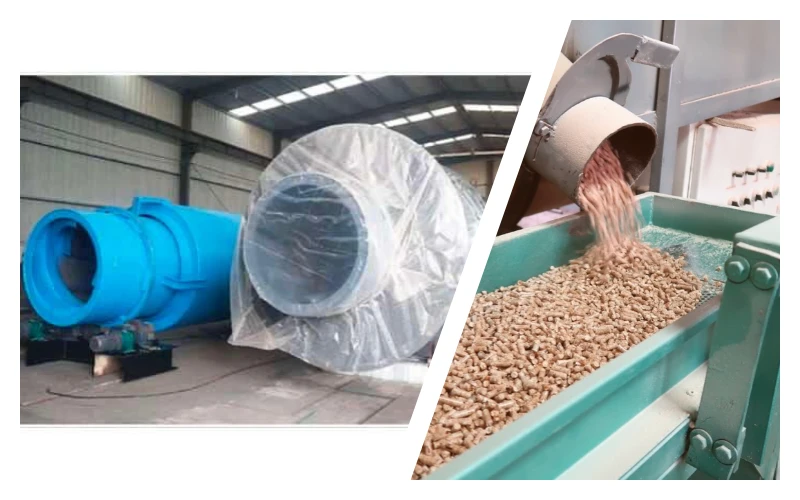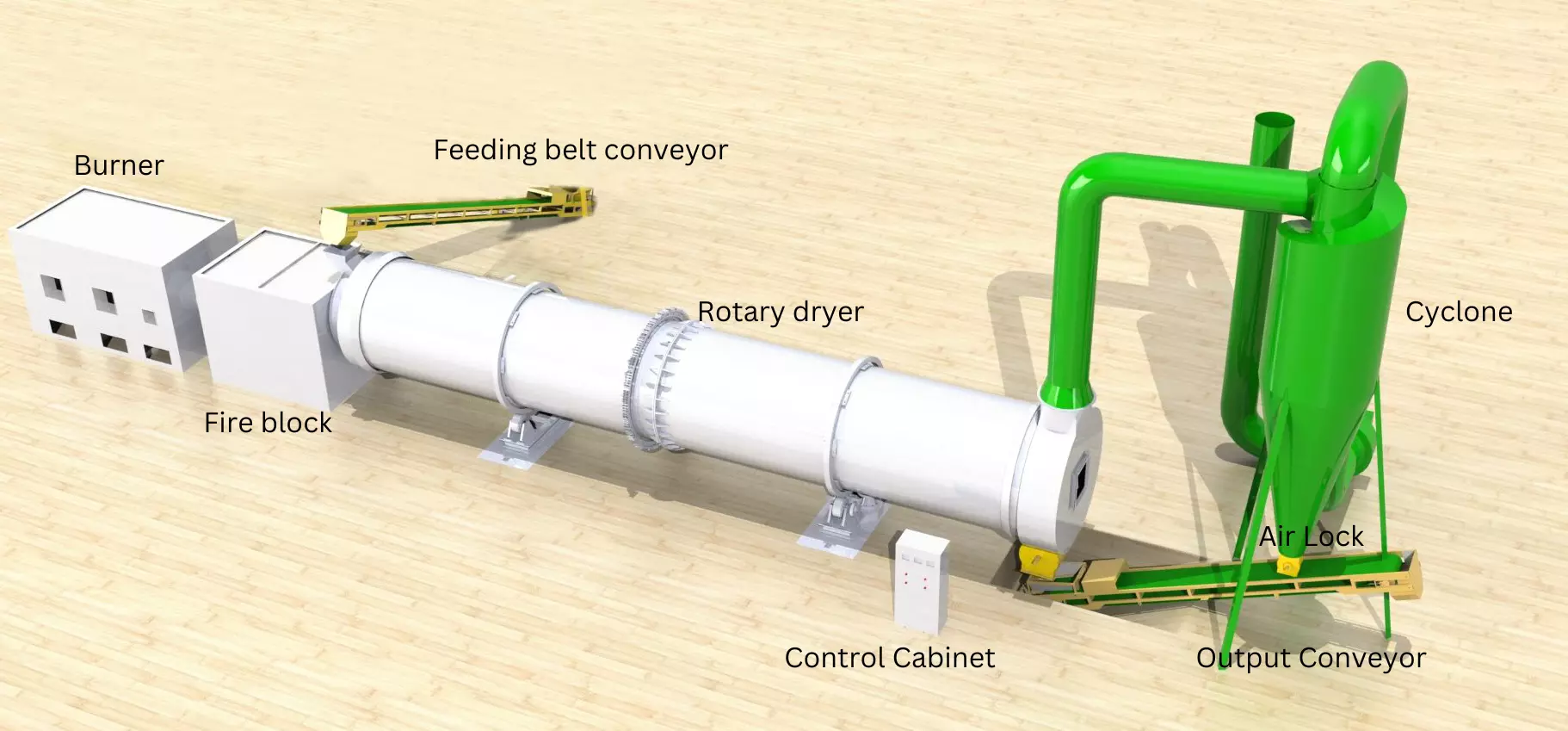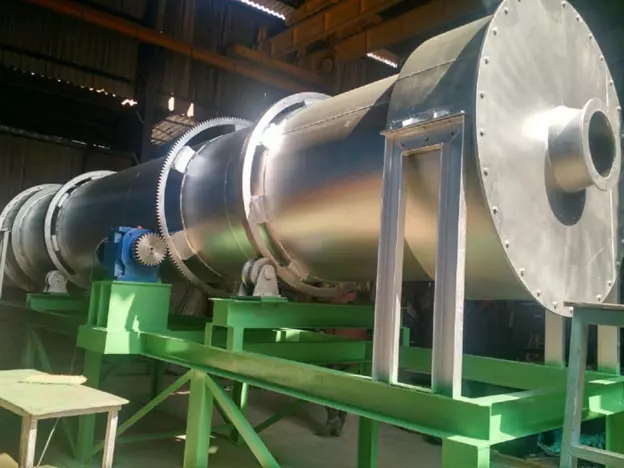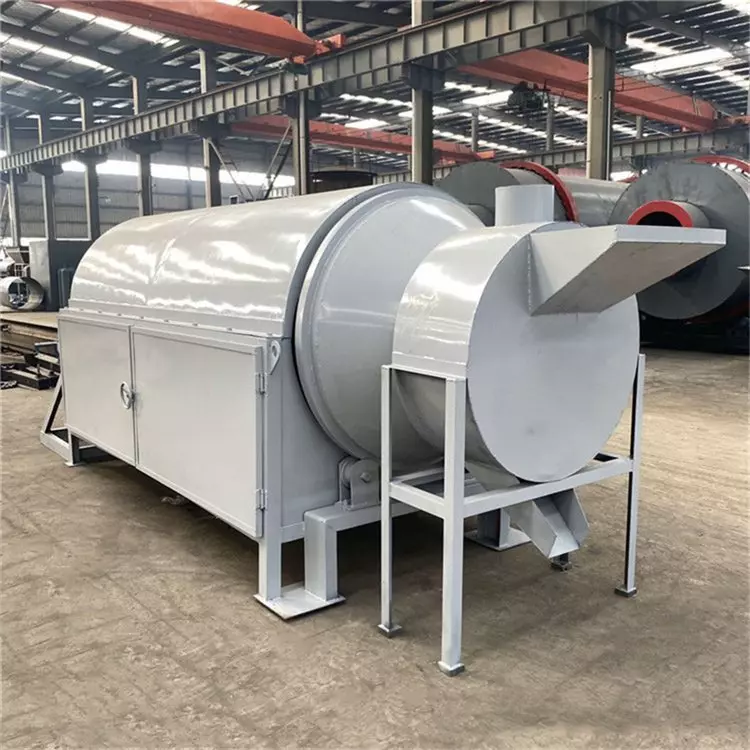
The Ultimate Guide to Rotary Drum Dryers: Comprehensive Insights and Best Practices
Rotary drum dryers are versatile industrial machines that play a crucial role in the drying process across various industries1. They are designed to efficiently remove moisture from different types of materials, ensuring optimal dryness levels.
In this comprehensive article, we will delve into the basics of rotary drum dryers, explore their features, working mechanisms, different types, and applications in various industries, and we will suggest you the top choice for high-quality and cost-effective rotary drum dryer solutions.
Features and Working Mechanisms of Rotary Drum Dryers
Structure and Components of Rotary Drum Dryers
Rotary drum dryers consist of a cylindrical drum that rotates on its axis. The drum is typically inclined slightly to facilitate the movement of material through it. The inner surface of the drum is equipped with lifting flights or fins, which promote the agitation and tumbling of the material, ensuring uniform drying.
The drum is supported by trunnion wheels and driven by a motor, usually through a chain or gear system2.
The dryer is equipped with various components to facilitate the drying process. These include feed and discharge chutes, seals to prevent air leakage, burner or heating elements for providing the necessary heat, and exhaust systems to remove moisture-laden air and gases.
Additionally, some rotary drum dryers may incorporate insulation to enhance energy efficiency and minimize heat loss2

How Do A Rotary Dryer Work?
The working principle of rotary drum dryers involves the transfer of heat to the material being dried. The process begins by feeding the wet material into the dryer through the feed chute.
As the drum rotates, the lifting flights pick up the material and drop it through the hot air stream. This continuous movement exposes the material to the heat, causing the moisture to evaporate.
The hot air required for the drying process can be generated using different methods. Direct combustion involves using burners or heating elements within the dryer, where the hot combustion gases flow directly through the drum, making direct contact with the material.
This method is suitable for materials that can withstand direct exposure to high temperatures.
Alternatively, indirect methods can be employed to heat the drum. In these cases, the hot gases do not come in direct contact with the material.
The heat is generated externally and transferred to the drum through conduction or convection. Indirect rotary drum dryers are ideal for heat-sensitive materials or when the process requires isolation from combustion gases.
During the drying process, the moisture-laden air is expelled through the exhaust system, while the dried material exits the dryer through the discharge chute.
The speed of the drum rotation, the temperature of the drying air, and the design of the lifting flights can be adjusted to optimize the drying process for different materials and desired moisture levels2.
Different Types of Rotary Drum Dryers
Rotary dryers come in various configurations to accommodate different drying needs.
Let’s explore some common types:
Direct Rotary Dryers:
In direct rotary dryers, the hot combustion gases flow directly through the drum, making direct contact with the material being dried. These dryers are suitable for materials that can withstand direct exposure to high temperatures.
Indirect Rotary Dryers:
Indirect rotary dryers use external heating sources to heat the drum, and the hot gases do not come in direct contact with the material. This type is ideal for heat-sensitive materials or when the process requires isolation from combustion gases.
Concurrent Flow Rotary Dryers:
In concurrent flow dryers, both the material and the drying air flow in the same direction. This configuration offers high thermal efficiency but may have limitations for certain materials.
Counter-Flow Rotary Dryers:
Counter-flow dryers have the material and the drying air flowing in opposite directions. This design allows for efficient heat transfer and is suitable for materials with high moisture content.
Co-current and Counter-current Combination Dryers:
Combination dryers utilize both co-current and counter-current flows in different sections of the dryer. This design offers flexibility and can provide optimal drying conditions for various materials.
Each type of rotary dryer has its advantages and is selected based on factors such as material properties, required drying capacity, energy efficiency, and environmental considerations3.
Applications of Rotary Dryers in Various Industries
Rotary dryers find extensive applications across numerous industries due to their versatility and efficiency. Let’s explore some notable applications:
Mining and Minerals:
Rotary dryers are commonly used in the mining and minerals industry to dry minerals, ores, and concentrates. They are particularly valuable in processing materials like coal, gypsum, limestone, and phosphate, reducing moisture content for downstream processing4.
Agro-Processing:
In the agricultural sector, rotary dryers are employed for drying crops, grains, fruits, and vegetables. By reducing the moisture content, rotary dryers ensure longer shelf life, prevent spoilage, and improve the overall quality of agricultural products5.
Chemical Industry:
The chemical industry extensively utilizes rotary dryers to dry various chemical substances, including fertilizers, pigments, dyes, and pharmaceutical intermediates.

Rotary dryers are instrumental in achieving the desired moisture levels and ensuring product stability6.
Food and Beverage: Rotary dryers play a crucial role in the food and beverage industry.
They are utilized to dry products like coffee, tea, grains, spices, and cocoa beans. By removing excess moisture, rotary dryers preserve the quality, flavor, and aroma of food products, enhancing their shelf life7.
Waste Management:
Rotary dryers are an integral part of waste management processes, effectively drying municipal solid waste, sludge, and other waste materials before disposal. This reduces the volume of waste, facilitates proper handling, and prepares waste for further treatment or disposal8.
Wood and Biomass:
Rotary dryers are extensively used in the wood and biomass industries. They are crucial for drying wood chips, sawdust, and biomass materials, allowing for efficient energy production through combustion or biomass pelletization9.
Mineral Processing:
Rotary dryers are commonly employed in mineral processing operations to dry and process various minerals, such as potash, phosphate, and nickel. The removal of moisture improves handling, reduces transportation costs, and prepares minerals for subsequent processing steps10.
Construction Materials:
Rotary dryers are utilized in the construction industry to dry construction materials like cement, sand, and aggregates. The controlled drying process ensures optimal moisture levels in construction materials, enhancing their quality and performance11.
These are just a few examples of the wide-ranging applications of rotary dryers. Their adaptability and effectiveness make them indispensable in numerous industrial processes.
TCPEL’s Rotary Dryers
When it comes to selecting the right rotary dryer for your specific needs, TCPEL stands out as a trusted and reliable manufacturer. TCPEL offers a diverse range of rotary dryers that are renowned for their exceptional quality, durability, and performance. Our machines are engineered with precision and built to withstand demanding industrial environments.

What sets TCPEL apart is its commitment to delivering the best value to its customers. TCPEL’s rotary dryers not only offer competitive pricing but also ensure superior drying efficiency, reducing operational costs for businesses.
The company’s extensive experience and expertise in the field allow them to provide customized solutions tailored to each customer’s requirements.
TCPEL focuses on continuous improvement and customer satisfaction, constantly refining their rotary dryer designs to enhance performance, energy efficiency, and ease of maintenance. With a strong emphasis on quality control and stringent manufacturing processes, TCPEL has established itself as a leader in the rotary dryer market.
By choosing TCPEL as your rotary dryer supplier, you can expect:
● Quality and Durability: TCPEL’s rotary dryers are built to last, incorporating robust construction, high-quality materials, and reliable components. This ensures long-term performance and minimal downtime.
● Efficiency and Cost-effectiveness: TCPEL’s rotary dryers are designed for optimal drying efficiency, reducing energy consumption and operational costs. Their machines are engineered to deliver superior performance while minimizing resource usage.
● Customization: TCPEL understands that each customer’s drying requirements may vary. They offer customized rotary dryer solutions, tailoring the design, size, and specifications to meet specific needs and ensure optimal drying results.
● Technical Expertise: TCPEL boasts a team of knowledgeable experts who provide comprehensive technical support, from initial consultation to installation and maintenance. Their expertise ensures seamless integration of rotary dryers into existing operations and optimal performance.
● After-sales Service: TCPEL values long-term customer relationships and provides excellent after-sales support. They offer maintenance services, spare parts availability, and technical assistance to ensure the smooth operation and longevity of their rotary dryers.
The Final Word
Rotary dryers are indispensable equipment in various industries, facilitating efficient drying and enhancing overall productivity. Understanding their features, working mechanisms, different types, and applications is crucial for selecting the right dryer to meet specific requirements.
When it comes to rotary dryers, TCPEL emerges as the top choice, offering high-quality machines at competitive prices. TCPEL’s commitment to excellence, durability, customization, and customer satisfaction sets them apart from the competition.
By choosing TCPEL, businesses can expect exceptional performance, reliability, and cost-effectiveness, making them the preferred partner for all drying needs.
To explore TCPEL’s extensive range of rotary dryers and benefit from their expertise, visit their website and get in touch with their knowledgeable team today.
Contact TCPEL now to discuss your rotary dryer requirements and experience unmatched quality and affordability.
Talk to An Expert
SHARE THIS POST
Talk to An Expert
